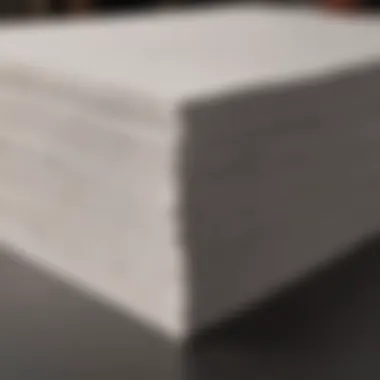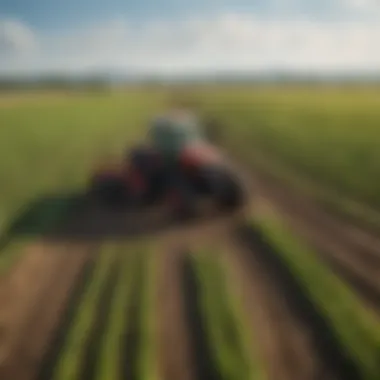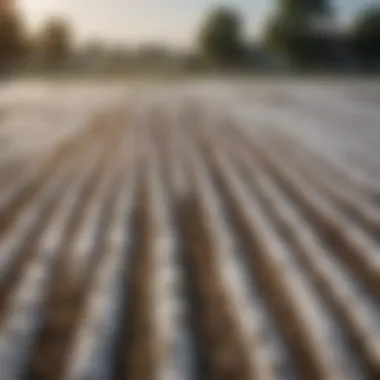Understanding White Coroplast in Agriculture


Intro
The agricultural sector constantly seeks innovative materials to enhance productivity and sustainability. One such material gaining attention is white coroplast. Understanding its various applications and benefits can transform how farmers and horticulturists manage their practices. In this article, we will explore the properties, uses, and significance of white coroplast in agriculture, providing insights that can help improve efficiency and environmental stewardship.
Overview of the Topic
Definition and Importance
White coroplast is a type of corrugated plastic, often made from polypropylene. This material is lightweight, durable, and resistant to moisture, making it ideal for outdoor use. It is used in myriad agricultural applications, including signage, seed pots, and protective coverings for crops. Its significance lies in its ability to withstand harsh weather conditions while contributing to efficient farming practices.
Current Trends
As agriculture shifts towards more sustainable methods, the use of materials like white coroplast is becoming more prevalent. Many farmers are adopting this material for its versatility and environmental benefits. Current trends indicate a growing focus on eco-conscious farming, where materials with lower carbon footprints are favored. White coroplast aligns well with this movement, offering an alternative to traditional materials that may have detrimental environmental impacts.
Key Techniques and Practices
Step-by-Step Guide
Implementing white coroplast in agricultural practices requires careful consideration of its applications. Here is a simple guide on how to use it effectively:
- Assess Your Needs: Determine which agricultural challenges you are facing. Are you looking for better signage or improved crop protection?
- Select the Right Product: Depending on your needs, you can choose from various sizes and strengths of white coroplast sheets.
- Prepare the Area: Ensure the installation area is clean and free from debris. This helps in the longevity of the material.
- Secure Coroplast Panels: Use stakes or clamps to hold the coroplast in place. This prevents movement during windy conditions.
- Monitor Performance: Regularly check the integrity of the coroplast for wear and tear, and replace as necessary.
Tools and Equipment Needed
To work with white coroplast, you will need basic tools such as:
- Utility knife for cutting the sheets
- Ruler for measuring
- Stakes or brackets for securing
- Marking pen to label or indicate positioning
Challenges and Solutions
Common Obstacles
While white coroplast offers various benefits, challenges can arise, including:
- UV degradation over time
- Limited flexibility compared to other materials
- Initial costs when purchasing in bulk
Innovative Solutions
Addressing these obstacles can ensure better use of white coroplast:
- UV Protection: Consider using UV-protected coroplast to extend the lifespan.
- Flexible Options: Pair the coroplast with more flexible materials for applications requiring bending and shaping.
- Bulk Buying: Collaborate with local farmers to purchase coroplast in bulk, reducing costs for everyone involved.
"White coroplast serves as a practical solution for both traditional and innovative farming techniques, enhancing productivity while supporting sustainability."
By understanding white coroplast and its applications, farmers can make informed decisions that impact their operations positively. This material stands as a testament to the ongoing evolution in agriculture, where efficiency and environmental practices go hand-in-hand.
Preamble to White Coroplast
White coroplast holds significant value in agriculture due to its diverse range of applications and unique properties. This section will explore the relevance of this material, highlighting its benefits and considerations that make it an essential component in modern farming practices. White coroplast, composed primarily of polypropylene sheets, offers a lightweight yet durable solution for various agricultural needs. As farmers and horticulturists look for materials that enhance productivity while also being cost-effective, understanding the roles and applications of white coroplast becomes essential.
Definition and Composition
White coroplast is a type of corrugated plastic material known for its rigidity and resilience. The product is made from a copolymer of polypropylene, giving it a distinctive layered structure. The hollow channels within the sheets contribute to its strength while maintaining a lightweight quality. This design also provides insulation, making it effective for various uses in agriculture, from signage to plant containers. The properties of this material allow it to withstand harsh environmental conditions, showcasing its versatility in different agricultural settings.
Historical Context
The history of coroplast can be traced back to the mid-20th century when it was first introduced as a reusable alternative to traditional materials. Its application in agriculture emerged as farmers sought durable and versatile solutions to improve farming efficiency. Over the years, the use of white coroplast has expanded, with advancements in its production and design. Farmers began employing it not just for signage, but also for innovative farming solutions, leading to increased productivity. The material has not only risen in popularity but also in its significance as agricultural needs have evolved. From traditional farming approaches to modern practices, white coroplast has adapted and provided critical support for sustainable agricultural operations.


Properties of White Coroplast
The properties of white coroplast are fundamental to understanding its significance in agricultural applications. These attributes not only highlight the material's functionality but also contribute to its efficacy in diverse farming practices. White coroplast is commonly chosen for its unique combination of lightweight characteristics, chemical resistance, and impressive durability. Each of these properties plays a crucial role in shaping its applications and benefits in agriculture.
Physical Attributes
White coroplast is notable for its lightweight nature, which makes it easy to handle and install. Ranging in thickness, typically from 4mm to 10mm, this material also features a hollow structure. This structure provides both rigidity and flexibility, allowing for various designs and implementations. Its lightness is particularly advantageous for farmers who need to transport and set up signs or protective structures quickly. The bright white surface reflects sunlight, which helps to keep crops sheltered from scorched soil and harmful overheating. Moreover, the texture of coroplast is non-porous, making it resistant to moisture absorption. Therefore, it remains effective in damp conditions, ensuring consistent performance in the field.
Chemical Resistance
Another important property of white coroplast is its impressive chemical resistance. This quality is particularly important in agriculture, where exposure to fertilizers, pesticides, and other agrochemicals is common. Coroplast can withstand many harsh chemicals without degrading. This resistance reduces the need for material replacement due to chemical damage. Farmers can depend on it for signage or protective covers with confidence that it will endure the rigors of agricultural settings. Additionally, this property supports sustainable practices, as it minimizes waste and encourages the use of durable materials.
Durability and Lifespan
Durability is a defining aspect of white coroplast. This material is engineered to resist wear and tear from both environmental factors and operational use. Exposure to UV rays, moisture, and fluctuations in temperature does not substantially affect its integrity. As a result, white coroplast can remain functional for an extended period, often lasting several years without significant degradation. This long lifespan translates to cost savings for farmers, as they do not need to frequently replace signage or equipment. Investing in high-quality white coroplast can lead to enhanced productivity, as it supports long-term agricultural practices efficiently.
"The exceptional properties of white coroplast make it a valuable ally in the agricultural sector, promoting sustainability and efficiency across various applications."
In summary, the physical attributes, chemical resistance, and durability of white coroplast collectively contribute to its appeal in agriculture. By understanding these properties, farmers and agricultural professionals enhance their ability to use white coroplast effectively in their operations.
Applications in Agriculture
The agricultural sector continuously evolves by adopting materials that enhance productivity and sustainability. One such material that stands out is white coroplast. Its versatility and functionality make it a valuable asset for various agricultural practices. Understanding its applications allows farmers and agricultural professionals to utilize this material effectively and optimize their efforts.
Signage and Marketing
White coroplast is widely recognized for its use as signage in agricultural settings. The material's durability and weather resistance make it well-suited for outdoor use. Farmers can create signs that withstand harsh conditions while providing clear, visible information to customers and workers. This can include directional signs, crop identification, and promotional messages.
Using white coroplast also allows for easy customization, enabling vibrant graphics that attract attention. This not only helps in improving marketing efforts but also enhances brand presence in competitive markets.
Crop Protection Solutions
Incorporating white coroplast in crop protection strategies is gaining traction among growers. This material can be fashioned into protective barriers. These barriers defend young plants against pests or unfavorable weather conditions, such as hail or excessive sunlight. The lightweight nature of coroplast makes it easy to deploy and remove as needed, providing a flexible solution for varying climatic challenges.
Moreover, using coroplast barriers can significantly reduce the need for chemical pesticides, contributing to more sustainable farming practices. This not only benefits the environment but also aligns with consumer demand for organic and chemical-free produce.
Growing Containers
Another significant application of white coroplast is in the creation of growing containers. This material offers a lightweight yet sturdy option for various types of planting. Coroplast containers are especially advantageous for starting seedlings in greenhouses or indoor environments, allowing for proper drainage and aeration.
The affordability of white coroplast means that farmers can easily scale their operations by using these containers without excessive costs. Additionally, the ease of cleaning and reusing coroplast growing containers contributes to increased efficiency and reduced waste.
Greenhouse Applications
White coroplast is finding its place in greenhouse construction and maintenance as well. Its reflective properties can enhance light distribution within a greenhouse. This ensures that plants receive adequate sunlight for optimal growth.
Additionally, coroplast panels can act as partitions or temporary walls, allowing for better climate control in different growing zones. This flexibility enables farmers to cultivate a wider array of crops simultaneously, maximizing space and potentially increasing yield.
"The adaptability of white coroplast in agricultural applications illustrates its pivotal role in modern farming techniques."
Advantages of Using White Coroplast
The discussion of White Coroplast cannot be complete without emphasizing its numerous advantages. Farmers and agricultural professionals should consider this material due to its diverse benefits. These factors play a crucial role in improving efficiency and reducing costs in various agricultural settings. Below, we expand on the prominent advantages of using white coroplast in agriculture.
Cost-Effectiveness
One of the primary advantages of white coroplast is its cost-effectiveness. The material is relatively inexpensive compared to alternatives like wood or metal. As a result, farmers can use it in various applications without straining their budgets. For instance, signs made of white coroplast are not only affordable but also durable, which means less frequent replacement costs.
Furthermore, the lightweight nature of coroplast reduces shipping expenses when procuring the material. This allows farmers to allocate resources to other critical areas of their operations. By opting for white coroplast, agricultural professionals can bolster their profitability with reduced input costs.
Lightweight Design


White coroplast has a lightweight design that significantly eases handling and transportation. This feature is especially beneficial when creating signs, plant protectors, or containers that need to be moved frequently. The reduced weight means that labor costs can decrease, as workers can easily manage the materials without specialized equipment.
Moreover, the lightweight aspect does not compromise strength. Coroplast can withstand various agricultural conditions while remaining light. This balance of properties allows for practical applications in different farming contexts, enhancing overall operational efficiency.
Ease of Handling
Handling white coroplast is another compelling benefit. Its structure allows for simple cutting, shaping, and mounting. Farmers can easily customize it to suit specific needs, whether creating signage or protective enclosures for plants. This adaptability fosters creativity in designing solutions tailored to unique agricultural requirements.
Beyond customization, the ease of handling reduces labor efforts, enabling personnel to focus on higher-priority tasks. Time saved through easier modification of coroplast applications can lead to increased productivity in specific farming activities.
Weather Resistance
Weather resistance is a significant advantage of white coroplast, particularly in agriculture where exposure to various environmental conditions is common. White coroplast can tolerate sunlight, rain, and wind, ensuring that crops and structures remain well protected.
This level of durability minimizes the impact of weather-related wear and tear, extending the lifespan of agricultural installations. Consequently, farmers don’t need to invest in frequent repairs or replacements, making it a reliable choice in any farming environment.
"Investing in materials that withstand diverse weather conditions is essential to sustaining agricultural productivity."
In summary, the advantages of using white coroplast make it a valuable asset in agricultural settings. Its cost-effectiveness, lightweight design, ease of handling, and weather resistance contribute to enhanced farming practices and productivity.
Environmental Considerations
Understanding the environmental impact of materials used in agriculture is increasingly important. White coroplast offers several advantages and considerations that align with sustainable practices. Farmers and agricultural professionals must evaluate how these materials fit within the broader context of environmental responsibility.
Sustainability of Materials
Sustainability involves using resources in a way that meets present needs without compromising future generations. White coroplast, made from polypropylene, has a lightweight and sturdy structure that minimizes its carbon footprint during production and transportation. The impact of this material on the environment is relatively low when compared to traditional agricultural materials. Additionally, due to its long lifespan and durability, white coroplast reduces the frequency of replacement, leading to less waste.
The material’s manufacturing process generates fewer pollutants when produced efficiently. The energy required for production is less than that for metals or wood, making it a viable option for eco-conscious farmers. This sustainability also extends to the end of its life cycle, since it can be repurposed or recycled.
Recyclability
Recycling is crucial in minimizing environmental impact. White coroplast is 100% recyclable. After its intended use, it can be collected and processed into new products rather than ending up in landfills. This characteristic supports the circular economy by keeping materials in play and reducing the demand for virgin resources.
Key points about recyclability of white coroplast:
- Minimal energy is required during the recycling process.
- Recyclable products can be made from post-consumer white coroplast, lowering overall waste.
- Proper disposal and recycling channels enhance its environmental benefits.
"The recyclability of white coroplast supports sustainable agricultural practices, reducing the environmental strain of production."
Farmers should be aware of the local recycling facilities that accept white coroplast to ensure responsible disposal. By engaging in these practices, agricultural professionals can contribute to sustainability efforts and reduce their ecological footprint.
Limitations of White Coroplast
While white coroplast is widely appreciated for its numerous benefits in agricultural applications, it is essential to recognize that it has its limitations. Understanding these constraints is crucial for farmers and agricultural professionals to make informed decisions about their use in various contexts. This section will discuss the key limitations associated with white coroplast, focusing on thermal sensitivity and limited load capacity.
Thermal Sensitivity
White coroplast exhibits a certain degree of thermal sensitivity, which can pose challenges in specific environments. This material is susceptible to warping or deformation when exposed to extreme temperatures. In hot weather, the material can soften, leading to a compromised structure. Consequently, items stored in or transported using coroplast may face risks due to this sensitivity.
It is vital for users to consider the climate when utilizing white coroplast. For example, in regions where temperatures soar regularly, relying solely on coroplast for protective solutions can be less than ideal. Understanding these boundaries can help mitigate risks associated with heat exposure.
Maintaining ideal storage conditions is advisable. Confining white coroplast within temperature-regulated spaces can extend its longevity and performance.
Limited Load Capacity
Another notable limitation of white coroplast is its limited load capacity. While it is lightweight and convenient for many applications, this characteristic means it cannot support heavy weights without risk of damage. Farmers using coroplast for containers or structures must take this into account. Overloading coroplast can lead to structural failures, rendering it ineffective for intended uses.
For instance, when using white coroplast as a growing container or for crop protection, it is essential to avoid surpassing the recommended weight limits. Otherwise, the integrity of the containers can be compromised. Users should always assess weight distributions and avoid placing excessive stress on coroplast materials in applications such as signage, where bending or sagging could directly impact visibility and communication.


The optimal approach to working with coroplast involves understanding its weight limits and strategically planning its use. This can involve careful consideration of the materials placed on or within coroplast structures, ensuring they remain within safe parameters.
By recognizing the limitations of white coroplast, farmers can better utilize this material to enhance agricultural efficiency while avoiding pitfalls.
In summary, the limitations of white coroplast, particularly thermal sensitivity and load capacity, must be acknowledged by all users. Adapting practices to these constraints will ensure a more effective application in agricultural settings.
Best Practices for Using White Coroplast
White coroplast stands out as a useful material in agriculture, yet utilizing it effectively requires knowledge of best practices. Focusing on proper maintenance and installation is crucial for optimizing its benefits. When done right, these practices can significantly enhance the lifespan and performance of white coroplast in various applications.
Maintenance Strategies
Regular maintenance of white coroplast is key to preserving its integrity and functionality. Since this material can be exposed to various environmental factors, a few strategies are important to consider:
- Routine Cleaning: Regularly clean the surfaces of coroplast to remove dirt and debris. This ensures visibility for signage and prevents buildup that could degrade the material.
- Inspection for Damage: Periodically inspect for any bends, cracks, or other signs of wear. Addressing small issues before they escalate can extend the life of the coroplast.
- Avoid Harsh Chemicals: Use gentle cleaning solutions. Harsh chemicals can lead to deterioration of the material.
By implementing these strategies, farmers can maintain their coroplast structures effectively and ensure they serve their purpose for a longer period.
Proper Installation Techniques
The installation of white coroplast plays a vital role in how it performs in agricultural settings. Adhering to proper installation methods is essential to maximize its benefits. Here are some techniques to follow:
- Level Ground: Before installation, ensure the area is level. Uneven surfaces can lead to instability and damage over time.
- Secure Fastening: Use appropriate fasteners designed for coroplast. Securing the material correctly helps in preventing wind damage and adds to its overall durability.
- Consider Environmental Factors: Be aware of local weather conditions. In windy areas, additional supports or heavier weights may be necessary to anchor the coroplast properly.
- Test Fit Before Finalizing: During installation, conduct a test fit. This allows for any adjustments in placement that could improve overall effectiveness.
By following these installation techniques, users can prevent common issues that arise during use and enhance the performance of their white coroplast applications.
"Proper installation and maintenance are essential to harnessing the full potential of white coroplast in agricultural applications."
In summary, engaging in effective maintenance strategies and adopting proper installation techniques are vital for maximizing the advantages of white coroplast in agriculture, ensuring efficiency and longevity.
Future Trends in Agricultural Use
The agricultural sector is undergoing rapid changes, driven by innovation and the need for sustainable practices. Understanding the future trends in the use of white coroplast is crucial for farmers and agricultural professionals. This material shows promise in enhancing efficiency and productivity. As the sector moves towards more environmentally conscious practices, the role of white coroplast will likely grow.
Innovation in Material Science
Recent advances in material science have opened doors for new applications of white coroplast in agriculture. Manufacturers are exploring modified formulations that enhance its properties. For instance, adding additives can increase strength, making it more suitable for heavy-duty applications. These innovations can also improve its ultraviolet (UV) resistance, extending its lifespan in outdoor settings.
In addition, researchers are considering bioplastics and biodegradable alternatives to coroplast. While this might not fully replace white coroplast, it offers a complementary option for sustainable practices. This is important to consider as consumers demand more eco-friendly products.
Integrating Technology with Coroplast Applications
The integration of technology with white coroplast applications is another promising trend. Sensors can be embedded into coroplast structures to monitor environmental conditions closely. This technology enables farmers to track humidity, temperature, and light levels in real-time. Such data can inform decisions, improving crop yield and reducing resource wastage.
Moreover, drones are being used to assist in the implementation of coroplast-based solutions. They can deliver coroplast signs and materials precisely within farming spaces, optimizing logistics. As technology continues to evolve, the pairing of coroplast with advanced agricultural practices will likely become more seamless.
This synergy between traditional materials and modern technology makes white coroplast a vital component in the future of agriculture.
In sum, the future of white coroplast in agriculture hinges on material innovations and technological advancements. Embracing these trends can lead to improved practices that align with sustainability goals while enhancing productivity. Farmers adopting these trends stand to benefit significantly as they position themselves to meet evolving market needs.
Epilogue
The conclusion serves as a vital part of this article, summarizing the essence of white coroplast’s implications in agriculture. This material presents distinct advantages that cater to diverse agricultural needs. Understanding these can significantly influence farming practices and sustainability efforts within the sector.
Recap of Benefits
White coroplast is lightweight yet robust, making it a practical choice for various applications. Its resistance to moisture, UV rays, and chemical exposure means it can withstand challenging environmental conditions. The key benefits include:
- Cost Efficiency: Durable nature leads to fewer replacements, resulting in savings.
- Versatility: From signage to protective barriers, its uses are broad, enhancing operational efficiency.
- Eco-Friendliness: Being recyclable aligns with sustainable farming goals, supporting a circular economy.
This collection of benefits showcases why many agronomists and farmers increasingly choose white coroplast.
Final Thoughts on White Coroplast Usage
Looking forward, white coroplast will likely continue to evolve in its applications within agriculture. As farmers seek innovative solutions, this material can adapt to their changing needs. Considerations such as ease of handling and weather resistance will further enhance its attractiveness.



